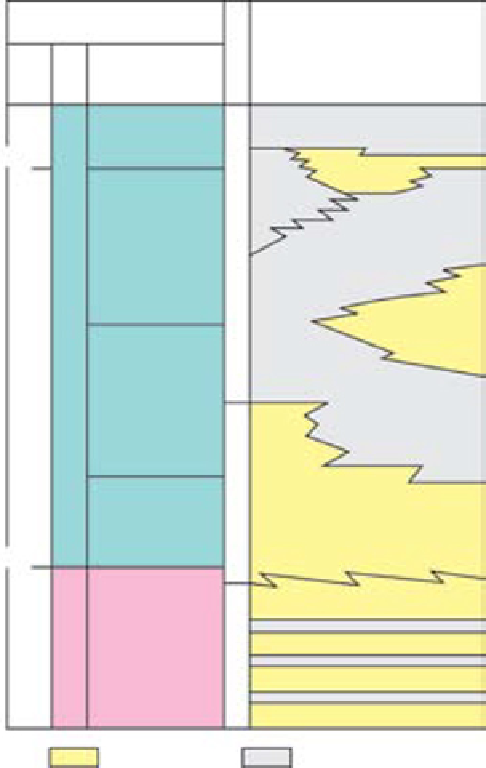Geoscience Reference
In-Depth Information
relatively large (Paola
et al
., 1992; Van Heijst &
Postma, 2001; Postma, 2014).
Timescale
Viking
Graben
Horda
Platform
Time
(Ma)
Age
ACCOMMODATION TO SEDIMENT
SUPPLY RATIO: SIGNIFICANCE,
RECOGNITION AND TRENDS
Drake Fm.
Toarcian
183.0
Cook
Fm.
Burton
Fm.
Allocyclic and autocyclic control
Pliensbachian
Although the method advocated here is data
driven, it is required to embrace a conceptual ele-
ment to be able to construct a stratigraphic zona-
tion. It is therefore necessary to apply 1) the concept
of accommodation (see Appendix I) to sediment
supply ratio (A/S) based on the regime theory of
Swift & Thorne (1991) and Thorne & Swift (1991)
and 2) principles of autostratigraphy as defined by
Muto
et al
. (2007) for the definition, recognition
and correlation of time equivalent stratigraphic
surfaces or zones that potentially improve the abil-
ity to correlate (cf. Catuneanu, 2006).
At time scales of 10 ka to 1 Ma, scale-dependant
erosional-depositional thresholds can be defined
in fluvial systems that separate the modes of fluvial
aggradation and degradation (Bull, 1991). These
thresholds are controlled, at the largest scale, by
two groups of allocyclic factors: climatic and tec-
tonic processes. These two groups interact with
each other in a complex manner, making it often
difficult to ascribe changes in continental fluvial
architecture to a particular tectonic or climatic
cause. A significant change in one or both of the
external controls will lead to a change in fluvial
behaviour (Schumm, 1977, 1993; Bull, 1991). Bull
(1991) argued that aggradation or degradation
occurs during climate changes with the fluvial
system attaining equilibrium during much of the
remaining time. During climate changes, vegeta-
tion shifts on hill slopes and the fluvial system
responds by releasing sediment which leads to
aggradation. Examples of this fluvial response to
climate change are given by Weissmann
et al
.
(2002, 2005) for a fluvial system developed during
glacial and interglacial periods and by Gibling
et al
.
(2005) for a monsoonal system. These studies show
that degradation and exposure of the fluvial system
covers most of the time recorded by the fluvial sed-
iments, with relatively short bursts of aggradation
due to climate change. For purposes of (sequence)
stratigraphic analysis, allocyclic factors, operating
at long spatial and temporal scales, need to be sepa-
rated from autocyclic processes (the natural cyclic
Johansen
Fm.
Amundsen
Fm.
Sinemurian
Nansen
Fm.
Eiriksson Fm.
Hettangian
Raude Fm.
199.6
Lunde
Rhaetian
Fm.
Sandstone
Siltstone/mudstone
Fig. 3.
Early to Middle Jurassic lithostratigraphy of the
Viking Graben and Horda Platform structures (see Fig. 1)
in the Tampen area with the Statfjord Group indicated.
Modified after Husmo
et al
. (2003) and Lervik (2006).
and sediment flux variations causes an effect on
physical processes of fluvial sedimentation. Long-
term climatic variations (>10
4
yr) as expressed in
fluvial stratigraphy are ultimately controlled by
Milankovitch scale variations in insolation pat-
terns and their effect on, for example, vegetation
(Perlmutter & Matthews, 1990; Matthews &
Perlmutter, 1994; Fraticelli
et al
., 2004; Weissmann
et al
., 2002, 2005; Gibling
et al
., 2005). In addition,
allogenic forcing keeps a fluvial system continu-
ously out of balance and changes its accumulation
space and consequently the aggradation rate
(Postma, 2014). Particularly, if the time period for
the change in accumulation space is much shorter
than the time period that the fluvial system requires
to reach grade, the change in aggradation rate is

Search WWH ::

Custom Search